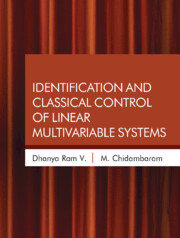Book contents
- Frontmatter
- Contents
- Preface
- Acknowledgements
- List of Abbreviations
- Notations
- 1 Models, Control Theory, and Examples
- 2 Identification and Control of SISO Systems
- 3 Introduction to Linear Multivariable Systems
- 4 CRC Method for Identifying TITO Systems
- 5 CRC Method for Identifying SISO Systems by CSOPTD Models
- 6 CRC Method for Identifying TITO Systems by CSOPTD Models
- 7 Identification of StableMIMO System by Optimization Method
- 8 Identification of Centralized ControlledMultivariable Systems
- 9 Identification of Multivariable SOPTD Models by Optimization Method
- 10 Identification of Unstable TITO Systems by Optimization Technique
- 11 Centralized PI Controllers Based on Steady State Gain Matrix
- 12 SSGM Identification and Control of Unstable Multivariable Systems
- 13 Control of Stable Non-square MIMO Systems
- 14 Control of Unstable Non-square Systems
- 15 Trends in Control ofMultivariable Systems
- Appendix A Identification of Unstable Second Order Transfer Function Model with a Zero by Optimization Method
- Appendix B For Chapter 3
- Appendix C For Chapter 7
- Bibliography
- Index
15 - Trends in Control ofMultivariable Systems
Published online by Cambridge University Press: 31 July 2022
- Frontmatter
- Contents
- Preface
- Acknowledgements
- List of Abbreviations
- Notations
- 1 Models, Control Theory, and Examples
- 2 Identification and Control of SISO Systems
- 3 Introduction to Linear Multivariable Systems
- 4 CRC Method for Identifying TITO Systems
- 5 CRC Method for Identifying SISO Systems by CSOPTD Models
- 6 CRC Method for Identifying TITO Systems by CSOPTD Models
- 7 Identification of StableMIMO System by Optimization Method
- 8 Identification of Centralized ControlledMultivariable Systems
- 9 Identification of Multivariable SOPTD Models by Optimization Method
- 10 Identification of Unstable TITO Systems by Optimization Technique
- 11 Centralized PI Controllers Based on Steady State Gain Matrix
- 12 SSGM Identification and Control of Unstable Multivariable Systems
- 13 Control of Stable Non-square MIMO Systems
- 14 Control of Unstable Non-square Systems
- 15 Trends in Control ofMultivariable Systems
- Appendix A Identification of Unstable Second Order Transfer Function Model with a Zero by Optimization Method
- Appendix B For Chapter 3
- Appendix C For Chapter 7
- Bibliography
- Index
Summary
In this chapter, some of the methods of designing multivariable control system are reviewed. These methods include Gain and Phase Margin (GPM) method, Internal Model Control (IMC) method, synthesis method, PI controllers with no proportional kick, analytical methods, method of inequalities, goal attainment method, Effective Transfer Function (ETF) method, and Model Reference Controller (MRC) design method.
Gain and Phase Margin Method
The gain and phase margins (GPMs) are typical loop specifications associated with the frequency response (Franklin et al., 1989). The GPMs have always served as important measures of robustness (Kaya, 2004, Lee, 2004). It is known from classical control that phasemargin is related to the damping of the system and can therefore also serve as a performance measure (Franklin et al., 1989). The controller design methods to satisfy GPM criteria are not new, and have been widely used (Ho et al., 1995; Hu et. al, 2011). Simple formulae are given by Maghade and Patre (2012) to design a PI/PID controller to meet user-defined Gain Margin (GM) and Phase Margin (PM) specifications.
Using definitions of GPM, the set of equations from Eq. (15.1) to Eq. (15.4) can be written.
where Amii and ϕmii are GM and PM respectively. Here ωgii and ωpiiare gain and phase crossover frequencies. The PI controller parameters are given for FOPTD model as in Eq. (15.5).
Where,
PID controller parameters with first order filter are as in Eq. (15.7) and Eq. (15.8).
It is recommended that a gain margin of 2 and phase margin of 45◦ can be used.
Internal Model Control Method
The concept of Internal Model Control (IMC) was introduced by Garcia & Morari (1982) for scalar systems, and further extended to multivariable (linear and non-linear) systems to design a decentralized control system by Garcia and Morari (1985a), Garcia and Morari (1985b), Ravera et al. (1986) and Economou et al. (1986). Garcia andMorari (1985a) extended themethod toMIMO discrete time systems.
A model predictive control law formulation is suggested by Garcia and Morari (1985b) for the computation of the IMC and the controller parameters can be calculated explicitly without inversion of the polynomia
- Type
- Chapter
- Information
- Publisher: Cambridge University PressPrint publication year: 2023



